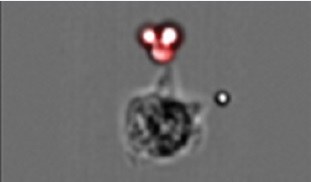New type of immune cells has a strong Czech footprint

The blood is made up of a large and, for the layman, relatively uncluttered number of cell types. A large class of those involved in the immune responses are the so-called antigen-presenting cells (APCs). These are able to uptake a foreign organic element, break it into very small pieces and expose them on their surface. The information presented in this way serves as a signal to other types of cells of the immune system that there is some kind of trouble,or infection going on.
 "Antigen-presenting cells have been known for years - but we discovered a few years ago that there is another type of such cells. We call these cells RORγt+ APCs, but unfortunately they don't have a shorter " and more sexy" name," smiles Jan Dobeš. The young Czech scientist's path to the discovery of these cells led him from search of the origin of a rare and complex autoimmune disease, which he studied during his PhD at the Institute of Molecular Genetics of the Czech Academy of Sciences in Dominik Filipp's group to his postdoc in the laboratory of Czech-born scientist Jakub Abramson at the Weizmann Institute of Science in Israel. Although Jakub Abramson's research was not specifically focused on these cells, his research on thymus cells, which are characterised by the expression of the biologically very important AIRE gene, which regulates the expression of about 6000 other genes, was a connecting factor. "This particular gene is also expressed in "our" RORγt+ APC cells, although it probably does completely different things there," explains Jan Dobeš, who now heads the Laboratory of Microbial Immunology at the Faculty of Science of Charles University. Although most studies have been based on the mouse model, which is overwhelmingly dominant in immunology, there are now several studies showing that humans have these cells too. However, the situation in human beings is understandably much less studied than in mice.
"Antigen-presenting cells have been known for years - but we discovered a few years ago that there is another type of such cells. We call these cells RORγt+ APCs, but unfortunately they don't have a shorter " and more sexy" name," smiles Jan Dobeš. The young Czech scientist's path to the discovery of these cells led him from search of the origin of a rare and complex autoimmune disease, which he studied during his PhD at the Institute of Molecular Genetics of the Czech Academy of Sciences in Dominik Filipp's group to his postdoc in the laboratory of Czech-born scientist Jakub Abramson at the Weizmann Institute of Science in Israel. Although Jakub Abramson's research was not specifically focused on these cells, his research on thymus cells, which are characterised by the expression of the biologically very important AIRE gene, which regulates the expression of about 6000 other genes, was a connecting factor. "This particular gene is also expressed in "our" RORγt+ APC cells, although it probably does completely different things there," explains Jan Dobeš, who now heads the Laboratory of Microbial Immunology at the Faculty of Science of Charles University. Although most studies have been based on the mouse model, which is overwhelmingly dominant in immunology, there are now several studies showing that humans have these cells too. However, the situation in human beings is understandably much less studied than in mice.
Two things are actually most interesting about the discovery of these cells. The first is that although they have the properties and capabilities of known antigen-presenting cells (APCs), they belong to a distinct cell lineage. "While APC cells come from the so-called myeloid lineage, which includes, for example, macrophages or dendritic cells, "our" RORγt+ APCs actually belong to cells from the lymphoid lineage, which includes, for example, T-cells. The question is whether this is something developmentally older or whether they are some kind of addition to myeloid cells," says Jan Dobeš. Another interesting fact is that these cells are apparently a very important factor in shaping the body's immune responses. Over the last five years or so, several more reports have come out confirming that this type of cell does exist and has various functions. Last year, Jan Dobeš and Jakub Abramson's team published a paper showing that these cells play a key role in the body's immune response against yeast infections in the oral cavity and gut. Several groups in the US have in turn discovered that these cells can modulate the function of T-lymphocytes so that they do not attack the gut microbiota. A poorly tuned immune response against the gut microbiota can lead to unpleasant conditions like inflammatory bowel diseases (Crohn's disease).
 Jan Dobeš, Ph.D., photo: Jan Juračka
Jan Dobeš, Ph.D., photo: Jan Juračka
The fact that these cells and their function was newly discovered by several laboratories has created a bit of confusion in the scientific community - everyone has called them differently, described them from different angles. "This was the very reason why we were invited, together with two groups from USand an Israeli group of Jakub Abramson, to write a review paper summarizing the advances in research on these cells over the last 5 years or so. As this is a hot topic of research, more teams have started to focus on Roryt+ APCs - today there are 7 - 8 teams, which is quite a lot for immunology and we can expect more to come. One of the purposes of our review is to summarize the current knowledge regarding Roryt+ APCs and to bring the results from this dramatically developing field to the wider community," summarizes Jan Dobeš.
Jakub Abramson, Jan Dobeš, Mengze Lyu, Gregory F. Sonnenberg, The emerging family of RORγt+ antigen-presenting cells, https://doi.org/10.1038/s41577-023-00906-5
Document Actions